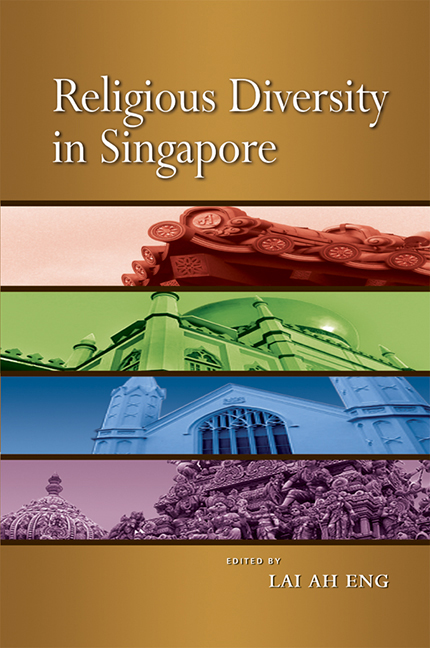Book contents
- Frontmatter
- Contents
- List of Figures and Tables
- List of Appendices
- FOREWORD
- PREFACE
- Acknowledgements
- The Contributors
- Abbreviations
- Glossary
- INTRODUCTION
- PART I The Landscape of Religious Diversity
- 1 Religious Influences and Impulses Impacting Singapore
- 2 Religious Trends and Issues in Singapore
- 3 Keeping God in Place: The Management of Religion in Singapore
- 4 Discourses on Islam in Southeast Asia and Their Impact on the Singapore Muslim Public
- 5 Global Christian Culture and the Antioch of Asia
- 6 “Religiously-inspired”, “India-derived” Movements in Singapore
- 7 Baha'is in Singapore: Patterns of Conversion
- 8 Diversities and Unities: Towards a Reformist Buddhism in Singapore
- 9 The Sathya Sai Baba Movement in Singapore: Its Service Mission and Philosophy of Communal Identity Construction
- 10 The Muslim Religious Elite of Singapore
- 11 The Evolution of the Sikh Identity in Singapore
- 12 Religious Processions: Urban Politics and Poetics
- PART II Religion in Schools and Among the Young
- PART III Religion in the Media
- PART IV Religious Organizations in Social Services
- PART V Interfaith Issues and Interaction
- Index
9 - The Sathya Sai Baba Movement in Singapore: Its Service Mission and Philosophy of Communal Identity Construction
from PART I - The Landscape of Religious Diversity
Published online by Cambridge University Press: 21 October 2015
- Frontmatter
- Contents
- List of Figures and Tables
- List of Appendices
- FOREWORD
- PREFACE
- Acknowledgements
- The Contributors
- Abbreviations
- Glossary
- INTRODUCTION
- PART I The Landscape of Religious Diversity
- 1 Religious Influences and Impulses Impacting Singapore
- 2 Religious Trends and Issues in Singapore
- 3 Keeping God in Place: The Management of Religion in Singapore
- 4 Discourses on Islam in Southeast Asia and Their Impact on the Singapore Muslim Public
- 5 Global Christian Culture and the Antioch of Asia
- 6 “Religiously-inspired”, “India-derived” Movements in Singapore
- 7 Baha'is in Singapore: Patterns of Conversion
- 8 Diversities and Unities: Towards a Reformist Buddhism in Singapore
- 9 The Sathya Sai Baba Movement in Singapore: Its Service Mission and Philosophy of Communal Identity Construction
- 10 The Muslim Religious Elite of Singapore
- 11 The Evolution of the Sikh Identity in Singapore
- 12 Religious Processions: Urban Politics and Poetics
- PART II Religion in Schools and Among the Young
- PART III Religion in the Media
- PART IV Religious Organizations in Social Services
- PART V Interfaith Issues and Interaction
- Index
Summary
INTRODUCTION
A fundamental observation in the sociological study of religion has been the rise of new religious movements and cults. Many scholars have attributed this phenomenon to the decline or the gradual secularization of traditional religions like Christianity (Nelson 1987; Johnstone 1997). History may have envisaged that religion has relentlessly come into focus as a struggle between the good old forces of institutionalized churches and disorder-seeking sects and cults. However, an intermediate ground-seeking innovation has been casting its shadow whilst the writings of the dominant discourses inspired by religious fervour continue. Carrying the popularly coined brand name of New Religious Movements (NRMs), they have continued to exist for long despite minimal writings on them. Beckford (1986) writes that “the idea of a religious movement implies an organized attempt to introduce changes in religion” (p. x). Often reformist in orientation, the term “movement” can be said to denote shifts in people's religious beliefs, ideas and conceptions which they were so used to in the older organized religious orientations.
What necessarily sparks the interest in these spiritual movements? Marshall (1994) points out that NRMs often tend to be syncretistic in nature, borrowing elements from many different religious and philosophical traditions. Sociologists in addition have made claims that such movements satisfy the psychological and social needs of young and modern people seeking a meaning in life, something they often fail to find easily within the mainstream religious traditions.
The religious economy thesis has dominated the discursive field of religion in the field of sociology with much success in the study and analysis of religious and cult movements both in the United States and Canada (Stark and Bainbridge 1985). However, it has been unable to account for the spread of other spiritual movements such as the Sathya Sai Baba movement and its global outreach. The religious economy thesis primarily lends itself to Christian and Western discourses. What is implicitly evident here is the operation of a Eurocentric bias with regards to Western exclusivist and religious conversion (Pereira 2005, p. 1).
In a nutshell, the concept of the religious marketplace implies that the conversion of an adherent requires the rejection of the parent religion, as is evident in sects, or the radical departure from established religions as is often characteristic of cults (Stark and Bainbridge 1985).
- Type
- Chapter
- Information
- Religious Diversity in Singapore , pp. 215 - 247Publisher: ISEAS–Yusof Ishak InstitutePrint publication year: 2008

